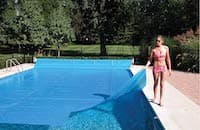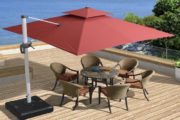This independent website is funded by its readers. It can earn a commission on any purchases made through product links, at no extra cost to the buyer. Learn more >
Can you run a variable speed pump with a salt chlorinator?
Sure you can, but it takes a little understanding, and a bit of planning.
A pool owner running a salt water system needs to understand how a variable speed pool pump functions. When the new federal law comes in which basically forces many pool owners over to variable speed pumps you need to be up to speed on how to set it up for your chlorination setup.
No-one likes to be forced into anything, especially something that’s going to cost plenty up front.
The good news is that migrating to a variable speed pump should save you plenty, and fast. A new VS pump purchase will start paying for itself from the first day it’s circulating your pool.
It’s always been a smart move to install a variable speed pump. They’ve a long list of benefits, the most significant they potentially consume 80 – 90% less energy. That’s why the government is so keen to phase out older less efficient pumps.
The energy companies, well they’re not so keen!!
We’re going to unpack everything you need to know about VS pumps and running them with salt chlorinators.
You’ll have all the tools you need to make the right pump purchasing decision, and how to set it up after installation. Let’s dive in…..
Are All VS Pumps Compatible With Salt Systems
The quick answer is yes. Well at least all the variable speed pumps we know of, and that’s a lot!!
They’ll all cope with the kinds of chlorine levels a normal domestic pool runs, typically 2500 to 3500 ppm. Many manufacturers advertise a maximum of 5000 ppm so that gives a comforting cushion if your chlorinator decides to go on a chlorine making binge one day.
If you notice a disclaimer on your preferred pump stating it’s not suitable for saltwater it generally means seawater not chlorinated pool water. Two very different things in terms of salt content. It’s worth checking before purchasing though, just to confirm.
Running a saltwater system already you’ll know how to take care of the pool chemistry. You just need to keep the same level of vigilance with your new VS Pump as the old timer you’re retiring. You’ll already know pH levels tend to creep then rapidly rise in your salt pool. Keep that down to the mid sevens just like before and all’s well.
Don’t worry, just keep up with your good maintenance practices. A variable speed pump has completely different super efficient technology running it but it’s obviously well sealed from the salt water system.
VS Pump Flow Rates And Salt Chlorinator
Here’s where things get a little trickier to answer. You won’t be used to considering flow rates. If you run an in-line salt system it always works with your old pump, that’s because the flow rate with your old pump was always above the minimum threshold to start the chlorinator.
A single speed pump runs flat out all the time (3450 RPM ) and a two speed is either full on or half on (3450 RPM or 1725 RPM) So both are going to fire up your salt generator.
A variable speed pump has more speed options and apart from the much more efficient PMM motor one of the factors lowering your energy bill is the pump speed. The lower the speed the less you pay. Obvious!
Manufacturers have produced estimated flow chart for their various VS pump models. This is an example for the excellent Hayward VS Super Pump, our recommended product range.

As you can see it’s quite helpful to pinpoint your installation setup. You’ll also see GPM is very dependent on TDH (Total Dynamic Head). TDH is a complex calculation that refers to the resistance your pool pump has to overcome as it pumps water round the system.
Finding The Best VS Pump Flow Rate
This takes a bit of trial and error to find the sweet spot for pool chlorination equipment or even pool heaters. Flow rate, pump run time and best chlorination levels need to be synced so they all work in harmony.
There’s no easy answer how to do this. Unless you’re running a system like the Hayward AquaRite. With this system chlorine delivery can be increased or decreased to match pump run time. A super handy feature, but if you’re running just a basic set up you can easily set things up.
The pool equipment pad is becoming more and more like the cockpit of a 747 Jumbo Jet. There’s lots of data to help todays new breed of digital pool owners fine tune their pool equipment. The fact is there’s read outs and micro chips all over the place to help you fine tune your VS pump and chlorinator combo.
High end pumps do have a digital read outs and pre-set flow rates at the pump, which makes life a little easier. But you can also dial in your own speeds, in the case of the Haywards VS Super Pump the owner can create four settings between between 600 and 3450 RPM.
Your chlorinator manual may give minimum flow rates to activate the system, or simply have a “No Flow” alarm on the digital control panel. It’s a matter of finding the pump RPM sweet point that the chlorinator kicks in at, then set the variable speed pump to run a little higher.
- The Hayward MaxFlo VS Variable-Speed 1.65 HP, 230V Pool Pump is the most efficient pump of its kind, according to EPA ENERGY STAR third-party testing, and maybe eligible for local utility rebates
- Can save up to 80% on energy costs, paying for itself faster than larger, more expensive models
- Permanent magnet, totally enclosed fan-cooled (TEFC) motor delivers maximum energy efficiency and reliability
Benchmarking The Flow Rate
Keep in mind when you are benchmarking you’re just taking a moment in the life of the circulating system. That means it’s going to change.
It might sound counter intuitive but for your tests we want a “dirty” system. Don’t be tempted to backwash the sand filter before or after fitting your brand new VS pump. We want a high pressure reading on the filter, that means a lower flow rate to the chlorinator. Make sense?
Now when you establish the flow rate your chlorinator kicks in you’ve got a real benchmark. Now just increase the pump RPMs over the chlorinator kick in rate and you’re good to go. So don’t set the benchmark margin too fine though, and backwash when you’ve finished, that will increase the flow rate a tad.
A way to avoid all this is to swop out the sand for sand filter balls. They tend to maintain a constant pressure to the system. We always recommend using them anyway if you’re planning a sand change. Find out more about why >>
An independent flow meter can be installed very cheaply too, it’s the only way to see realtime flow values. A flow meter is something all pools should have anyway. We explain here >>.
If your chlorine generator can’t run at the minimum pump flow rates it’s not the end of the world, don’t fret. The efficiency of the PMM motor fitted in your variable speed pump will still save you plenty of money at any RPM.
The Best Variable Speed Pumps
There’s no best variable speed pump, but there’s definitely the best pump for your installation. It’s not all about money either, paying top dollar doesn’t mean you’re buying the best fit for your pool.
Of course you’ll pay a premium if you buy from a recognised manufacturer with a solid pedigree. You get what you pay for, solid quality and solid engineering, but there are plenty of lesser known manufacturers with good products lines too.
Our recommended product line is the Haywards MaxFlo VS Pump. The range covers all pool sizes from above ground installations to large in ground pools.
Related Articles
Images from Amazon Product Advertising












